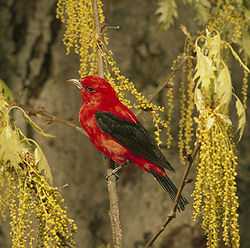Scarlet Tanager
| Scarlet Tanager | |
|---|---|
 | |
| Adult male | |
| Conservation status | |
| Scientific classification | |
| Kingdom: | Animalia |
| Phylum: | Chordata |
| Class: | Aves |
| Order: | Passeriformes |
| Suborder: | Passeri |
| Infraorder: | Passerida |
| Superfamily: | Passeroidea |
| Family: | Cardinalidae |
| Genus: | Piranga |
| Species: | P. olivacea |
| Binomial name | |
| Piranga olivacea (Gmelin, 1789) | |
| Synonyms | |
|
Piranga erythromelas | |
The Scarlet Tanager (Piranga olivacea) is a medium-sized American songbird. Formerly placed in the tanager family (Thraupidae), it and other members of its genus are now classified in the cardinal family (Cardinalidae).[2] The species' plumage and vocalizations are similar to other members of the cardinal family.
Description
Adults have pale stout smooth bills. Adult males are bright red with black wings and tail; females are yellowish on the underparts and olive on top, with olive-brown wings and tail. The adult male's winter plumage is similar to the female's, but the wings and tail remain darker. Young males briefly show a more complex variegated plumage intermediate between adult males and females. It apparently was such a specimen that was first scientifically described.[citation needed] Hence the older though somewhat confusing specific epithet olivacea ("the olive-colored one") is used rather than erythromelas ("the red-and-black one"), as had been common throughout the 19th century.
Behavior
Their breeding habitat is large forested areas, especially with oaks, across eastern North America. Scarlet Tanagers migrate to northwestern South America, passing through Central America around April, and again around October.[3] They begin arriving on the breeding grounds in numbers by about May and already start to move south again in mid-summer; by early October they are all on their way south.[4][5] The bird is an extremely rare vagrant to western Europe.
Scarlet Tanagers are often out of sight, foraging high in trees, sometimes flying out to catch insects in flight. They eat mainly insects and fruit.[6]
These birds do best in the forest interior, where they are less exposed to predators and brood parasitism by the Brown-headed Cowbird. Their nests are typically built on horizontal tree branches. Specifically their numbers are declining in some areas due to habitat fragmentation, but on a global scale tanagers are a plentiful species.
References
- ↑ BirdLife International (2012). "Piranga olivacea". IUCN Red List of Threatened Species. Version 2013.2. International Union for Conservation of Nature. Retrieved 26 November 2013.
- ↑ Remsen, J. V., Jr., C. D. Cadena, A. Jaramillo, M. Nores, J. F. Pacheco, M. B. Robbins, T. S. Schulenberg, F. G. Stiles, D. F. Stotz, and K. J. Zimmer. Version [2009-04-02]. [A classification of the bird species of South America. American Ornithologists' Union.
- ↑ Herrera, Néstor; Rivera, Roberto; Ibarra Portillo, Ricardo & Rodríguez, Wilfredo (2006): Nuevos registros para la avifauna de El Salvador. ["New records for the avifauna of El Salvador"]. Boletín de la Sociedad Antioqueña de Ornitología 16(2): 1–19. [Spanish with English abstract] PDF fulltext
- ↑ Henninger, W.F. (1906). "A preliminary list of the birds of Seneca County, Ohio". Wilson Bulletin 18 (2): 47–60.
- ↑ Ohio Ornithological Society (2004): Annotated Ohio state checklist.
- ↑ E.g. of Gumbo-limbo (Bursera simaruba). Trophis racemosa (Moraceae), and especially of Cymbopetalum mayanum (Annonaceae): Foster, Mercedes S. The potential of fruiting trees to enhance converted habitats for migrating birds in southern Mexico. doi:10.1017/S0959270906000554.
External links
| Wikimedia Commons has media related to Scarlet Tanager. |
| Wikispecies has information related to: Piranga olivacea |
- Scarlet Tanager Species Account – Cornell Lab of Ornithology
- Scarlet Tanager - Piranga olivacea USGS Patuxent Bird Identification InfoCenter
- Scarlet Tanager Stamps at bird-stamps.org
- Scarlet Tanager videos, photos, and sounds at the Internet Bird Collection
- Scarlet Tanager photo gallery at VIREO (Drexel University)
